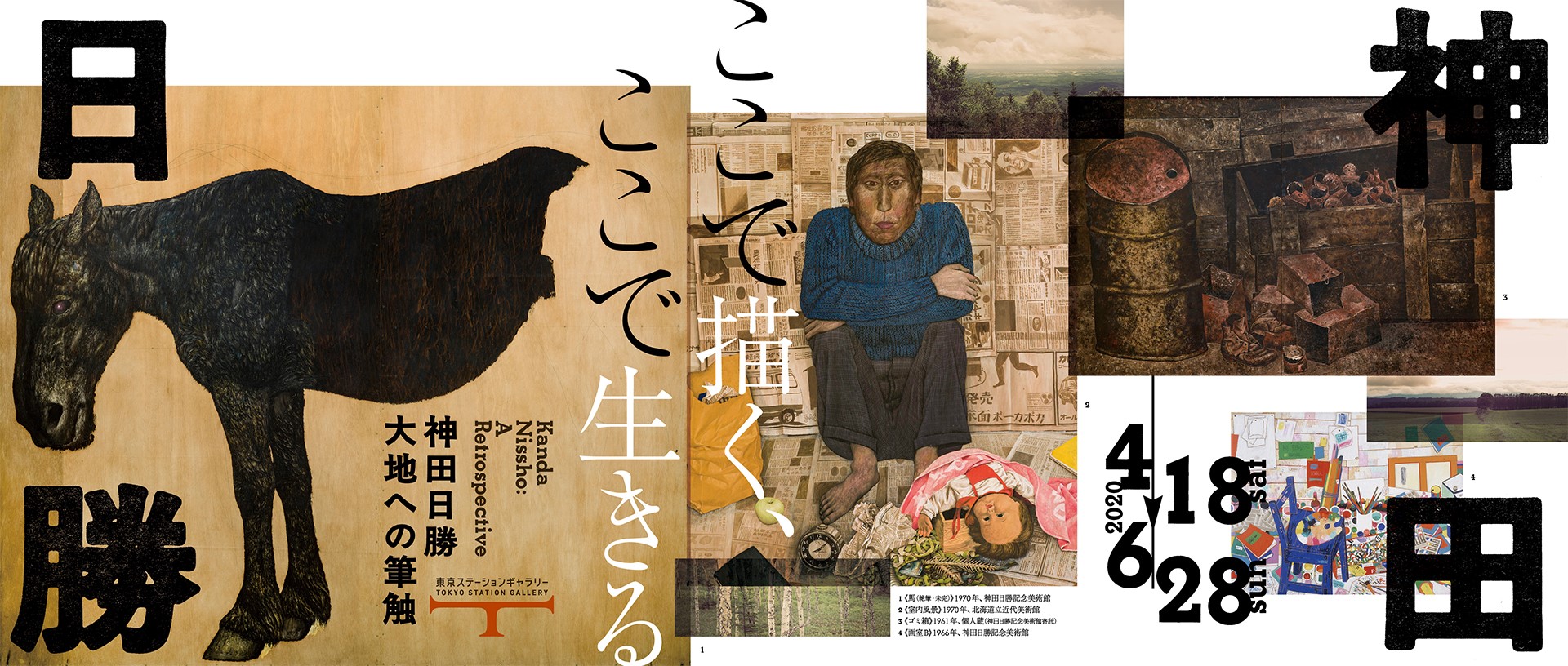
Kanda Nissho: A Retrospective
Tuesday, June 2 - Sunday, June 28, 2020
- Open everyday from June 2 - June 28, 2020
- Opening Hours
- 10:00 a.m. to 6:00 p.m.
*Fridays: Until 8:00 p.m.
*Last admission 30 minutes before closing time
Outline
- An Artist to Whom Living and Painting Were Indivisible
-
Kanda Nissho was an independent artist who continued to paint while working on a farm on the Hokkaido plains.
2020 marks the 50th anniversary of his death. To commemorate this, we are holding this large-scale retrospective of his works, the first to be held in Tokyo for 42 years.
Dead Horse, a vivid recreation of his childhood memory of a horse lovingly reared but lost to a fatal illness. Alone, where he superimposes his selves as a laborer and an artist in a portrait of his own face enclosed within a stiflingly claustrophobic space. Interiors, which seems to express Nissho’s inner unease due to the constant conflict of trying to balance his desire as an artist to paint to his heart’s content and the demands of his farming work. Horse (last work, unfinished), his final work showing half of a horse’s body. These and other works by Kanda Nissho overflow with the joy and sorrow, and the pride and anguish, of an artist to whom living and painting were indivisible.
This exhibition includes his most important works, and attempts to present the whole story about Nissho’s art. It offers an opportunity to explore in detail the evolution of his art, which repeatedly underwent great transformations.
- The Struggle to Develop Farmland, and the Joy of Painting
-
Kanda Nissho was born in Nerima, Tokyo in 1937. When Nissho was seven, his family relocated to Hokkaido, which was calling out for squads of conscripted farmers, in order to escape the flames of war. It was, however, August 14, 1945, the day before the war ended, when they finally arrived in the settlement of Shikaoi. The assistance promised by the state was practically non-existent, and it is not hard to imagine the hardships suffered by Nissho’s family as they cultivated the desolate land while enduring the intense cold of many winters.
As the family eked out an existence like that, Nissho started to draw, influenced by his elder brother Kazuaki, who later went on to study at the Tokyo University of the Arts. Nissho soon became fascinated by painting. After graduating from junior high school in 1953, Nissho decided to become an artist while still continuing to farm. He mainly had the opportunity to exhibit at events in Hokkaido, namely the Heigenshaten and the Zendouten, but his works gradually earned very high praise.
He was selected for the Dokuritsu Exhibition for the first time in 1964, the year of the Tokyo Olympics, and after that he continued to be selected for a number of exhibitions. It was from around that time that Nissho’s art became very colorful and he started to incorporate a very strong touch. These and other elements demonstrate how he was influenced by contemporary art, and his work can be seen to evolve greatly.
- His Unfinished Masterpiece
-
In 1970, while Japan was all excited about the Osaka Expo, Nissho was being overwhelmed with tasks such as farm work, creative work, and preparations for exhibitions. His physical condition deteriorated and he died on August 25, leaving his final work unfinished. Nissho was only 32 years old.
When he died, he left a painting still in progress in his art studio. That painting was Horse (last work, unfinished). It shows the front half of a horse. The head and front legs are finished, but only the first layer of paint has been applied for the abdomen, and the rest is just exposed plywood. It is considered a fascinating work that speaks to us of Nissho’s creative process. Even though only around a fifth of the painting has been completed, it depicts a horse that is throbbing with life, and the mismatched nature of the horse’s vacant stare has a tremendous impact that inspires a sense of fear in the viewer.
Painted with a touch imbued with the same spirit as if tilling the soil, each stroke seems filled with all the remaining life force Nissho could muster. It may be unfinished but it is his magnum opus, and it is no exaggeration to say that this masterpiece is an essential part of the history of contemporary Japanese art.
Highlights
This retrospective includes the most important works of Kanda Nissho, who died at the early age of 32, and attempts to present the whole story about his art. It is the first solo exhibition of his works to be held in Tokyo for 42 years.
This large-scale retrospective follows the course of Nissho’s artistic development, and incorporates the latest research as well as displaying works by contemporary artists who influenced him.
Kanda Nissho is the artist on whom the character of Yamada Ten’yō in the 2019 NHK morning drama series Natsuzora is modeled. The drama recreates many happenings from Nissho’s life.
Information
- Admission Fee
-
Adults : 1,100 yen, high school and university students : 900 yen
* Junior high school students and younger: Free
* For groups of 20 or more, admission fees are 800 yen for adults and 600 yen for high school and university students, but this discount is only available between April 19 and June 19.
* Persons with a disability certificate or similar receive a 100 yen discount on tickets purchased at the door, and one accompanying helper is admitted free.
Tickets can be purchased from Lawson Ticket (L-code=30066)
- Organized by
- Tokyo Station Gallery (East Japan Railway Culture Foundation)
- Sponsored by
- Ryugetsu
- Collaborated with
- Kanda Nissho Memorial Museum of Art
- Cooperated with
- The Hokkaido Shimbun Press, Hokkaido Museum of Modern Art
- Official website
- https://kandanissho2020.jp/